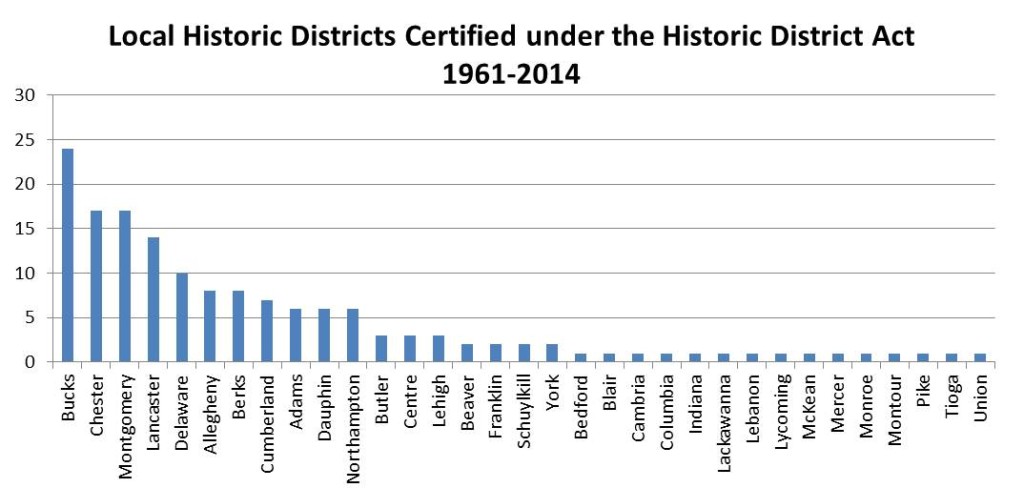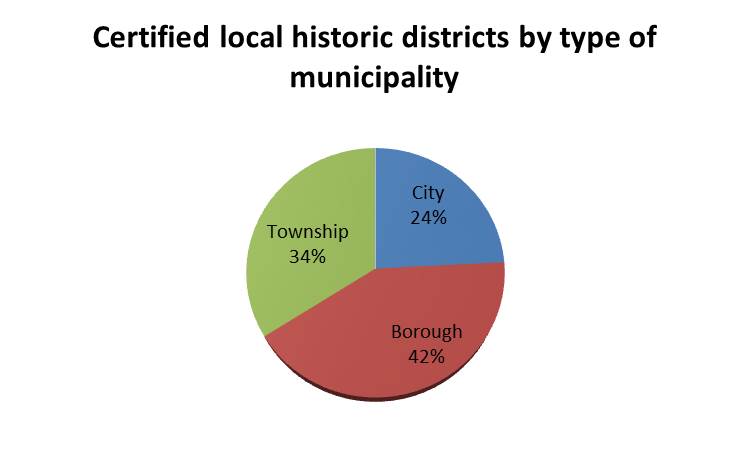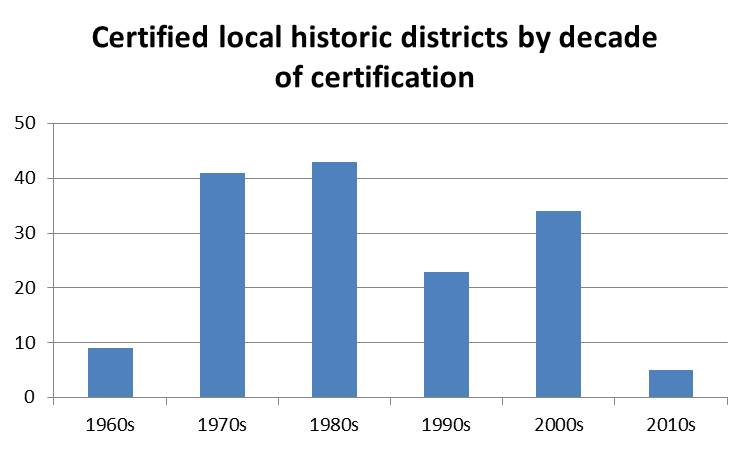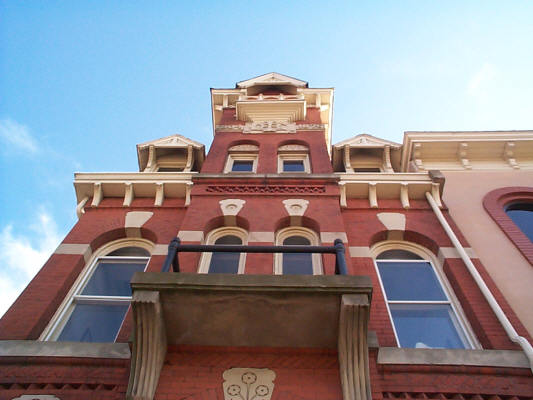Preservationists often refer to the range of programs, laws, and financial incentives that are invoked to help protect and enhance historic places as a “toolbox.” Among the tools in the toolbox may be planning and zoning regulations, grants, tax credits, state or Federal laws, to name just a few. The tools with the most “teeth” however, are often historic preservation ordinances enacted by a municipal government. The effectiveness of local ordinances when attempting to save a building from demolition or guide sensitive changes and alterations comes from the fact that generally speaking, only local governments have the ability to regulate property – both public and private. These tools are often misunderstood, though, and so I’ve compiled a short list of some common misconceptions about ordinances to shed some light on some nuances of how these programs work in Pennsylvania.
To set the stage, allow me to share a few numbers with you. I must confess that I’m a bit of a data geek, so I created a few graphs to help me understand where our districts are and when they were created.
As you’ll read more about in #3 below, PHMC plays a role in establishing historic districts under the Historic District Act. Between 1961 and 2014, the agency has certified the boundaries of 156 local historic districts in 94 municipalities in 34 of the Commonwealth’s 67 counties. The county with the most certified local districts is Bucks (24), with Montgomery, Chester, Lancaster, and Delaware Counties rounding out the top 5; Sixteen counties have at least 1 local district. The graph below shows all of the counties that have at least 1 certified local district established under the Historic District Act.

NOTE: Philadelphia, Pittsburgh, and Scranton are not included in this list because they designate districts under their Home Rule charters, not the Historic District Act.
The majority of these districts (42%) are located in one of the 47 boroughs with ordinances, while roughly one third (34%) of the districts are in townships, and the remaining quarter (24%) are in Third Class cities. 
The last bit of data to share is when these districts were designated. As the graph below shows, the 1980s were the most active years for local historic district designations, though significant numbers were certified in the 1970s and 2000s.

FUN FACT: The first local district certified under the Historic District Act was in Bethlehem, Northampton County on December 19, 1961. The most recently designated districts are in Buckingham Township, Bucks County, and Reading, Berks County and were certified on September 19, 2012.
1. Historic preservation ordinances are part of a municipality’s land use authority
Historic Preservation is occasionally thought of as a specialized activity – the domain of individuals or organizations with a particular interest in history or architecture. But, the authority to enact ordinances that create some level of protection for historic places, even privately owned ones, is part of the government’s police power (‘police’ here is used in the broadest sense of the word.) Before I go further – full disclosure – I am not a lawyer, so any thoughts expressed here are based on research compiled in consultation with attorneys and other knowledgeable sources, but do not constitute legal advice.
Generally speaking, the authority to regulate how property is used, constructed, and altered is reserved for the States by the establishment clause of the U.S. Constitution. This section allows government to undertake actions to “promote the general welfare”, which includes regulating the activities of individuals. Land use falls into this category, but because the Constitution does not expressly grant the Federal government jurisdiction over this issue, it’s delegated to the States. State governments, in turn, have the authority to delegate some of their roles and responsibilities to counties and municipalities as they see fit. As such, these local governments only have the authority to do what the State allows them to do, in the ways they allow them to do it.
Land use and building regulations are often delegated by States to municipalities in the form of enabling legislation – laws that allow (and sometimes require) municipalities to enact ordinances related to planning, zoning, and construction codes. Historic preservation ordinances, even ones with relatively weak review and protection requirements, are considered part of this same set of authorizations, though typically have separate enabling laws.
2.There are two state enabling laws for local preservation ordinances
In Pennsylvania there are two enabling laws that allow municipalities to enact historic preservation ordinances. The Historic District Act was passed by the Pennsylvania Legislature in 1961 and is the primary vehicle for local preservation programs. As the name suggests, it allows municipalities to designate portions of their communities that have significant concentrations of historic resources as historic districts. The owners of properties within these districts are then required to receive a special permit called a Certificate of Appropriateness (COA) before they may alter or demolish the building. Not all municipalities with ordinances require COAs for exterior alterations – some only require them for demolition, while others require COAs for new additions, roof replacement, siding, etc. Municipalities have some flexibility in choosing what is necessary and appropriate to require COAs for in their communities.
COA applications are reviewed by a Historic Architectural Review Board (HARB) that makes recommendations to the elected body (Council/Supervisors) about whether a COA should be issued for a particular project. The Council then votes to accept the HARB’s recommendation during a regular meeting. The HARB is comprised of at least 5 individuals from the community, and must include an architect, real estate broker, and building code official. All HARB members are appointed by the elected body.
The Municipalities Planning Code (MPC) is the other piece of enabling legislation for preservation ordinances. The MPC is the compilation of all of the planning and zoning authorities and requirements delegated to municipalities. Among these authorizations is the ability to classify properties “having unique historical, architectural or patriotic value” (Section 605[2]vi) and to enact regulations for their protection and enhancement. Because the MPC does not specifically limit the law to districts, this is the authority that many townships and rural communities use to protect individual buildings that may be scattered across the landscape, rather than in a concentrated area. The MPC also does not mention or require a HARB, but many communities have established historical commissions or preservation commissions to administer the ordinance.
3. PHMC’s role in implementing ordinances varies
While the authority to enact preservation ordinances rests entirely with the municipality, PHMC does play a role in their implementation under certain circumstances. The Historic District Act requires PHMC to “certify as to the historical significance of the district” before the municipality may begin enforcing it. In practical terms, this means that PHMC must render an opinion as to whether the boundaries of the regulated district are historically significant, and thus merit some form of regulation. The certification is made by the appointed members of the Commission based upon a recommendation from the BHP staff. Contrary to popular belief, PHMC is not required to, and does not certify the administrative or regulatory portions of an ordinance, so we don’t play any formal role in determining what types of activities require COAs or what criteria are used to make decisions about those applications.
In 2008 the Commission approved a new policy for the certification process. This policy places emphasis on whether the boundaries of the district (and the regulatory program by extension) support the municipality’s planning goals. The policy still limits the certification to districts, defined as
an area within a political subdivision that possesses a group of buildings, monuments, bridges, cemeteries, parks, designed landscapes, or other constructed or naturally-occurring features that have been recognized for their local historical or cultural significance either by the municipality or by the Pennsylvania Historical and Museum Commission.
However, one of the major factors that is considered when determining significance, is how the district relates to local planning documents and objectives. I’ll explore this relationship more in future posts, but the major point is that we’re seeking to empower municipalities to identify and determine what is significant to them, rather than forcing them to accept the boundaries set by other programs like the National Register of Historic Places (again, more on this in the near future).
One major point of clarification – PHMC’s certification role is limited to ordinances enacted under the Historic District Act. Ordinances created under the Municipalities Planning Code do not require PHMC involvement before properties are designated as historic. We don’t currently maintain data on how many communities have preservation ordinances enacted under the MPC.
Beyond the certification of boundaries, our staff, me included, don’t have an official role in drafting or implementing local ordinances. BUT we are more than willing to provide technical assistance and guidance to a municipality at any stage in the process. I am frequently asked to offer my advice on the best procedures to follow, effective language for the ordinance, clauses to avoid, the adoption process, etc. In those cases, I’ll review drafts, provide some guidance materials, or make suggestions based on the experiences of other communities and commonly accepted best practices. My goal is to help the community find the best solution for their needs, not simply adopt language written for somewhere else.
The Community Preservation Coordinators are your go to BHP contacts for assistance with local programs and ordinances, so feel free to contact Bill Callahan (Western PA), Bryan Van Sweden (Central PA), or myself with any questions you may have.
In a future post I’ll touch on a few more common items related to ordinances and local programs that cause some head-scratching.

Excellent article, Cory. Not just because I hail from Buckingham!